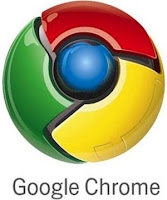Google Chrome, in theory and in practice
 This year has proved to yield quite serious news browser. Suffice it to recall that they were just a few months ago, we met a long anticipated release of many Firefox 3. And there in the early autumn of us proposed a preliminary version of the new pretender to storm Olympus market Web browsers, many have rushed to define a firm place in the group leaders. It is about Google Chrome.
This year has proved to yield quite serious news browser. Suffice it to recall that they were just a few months ago, we met a long anticipated release of many Firefox 3. And there in the early autumn of us proposed a preliminary version of the new pretender to storm Olympus market Web browsers, many have rushed to define a firm place in the group leaders. It is about Google Chrome.Started a new web browser, as it should be, in an atmosphere of heightened attention. He was not offended Note: news items, blogs, reviews, and all that - in the first days. The first reviews were written, as they say, hot pursuit, of course, interesting, but often sinned monotonous - repeated rows of press releases, discuss the characteristics of a pair of triple-interface. In order to experience the strengths and weaknesses in the application, to determine his place in his own «Arsenal» Online tools needed at least for a while. According to folk wisdom, it is necessary to live their minds, so let's try to understand themselves as new Google may be useful to us in networking. Here and now, not ever after, with the favorable location of the planets.
Brief description of Google Chrome
Well known formula, under which the vast majority of users will work with the application pre-installed on your computer. In this circumstance usually writes off the success Internet Explorer, supplied with Windows. Do not forget that «donkey» is constantly evolving, and many users really does not make sense to look for alternatives. In such a situation it is necessary to attract potential users. First, they should be interested - enough to find and download the browser. Secondly, it must offer them something that makes noticeably better than competitors. The process of installing the browser is simple and transparent. In addition to the main program, Chrome can put in startup application checks for new versions and updates to the browser site. The interface of Google Chrome is built on the familiar to Mozilla, Opera, and now - and even Internet Explorer 7 tabs. At the start page browser default image thumbnails are the most frequently visited your pages. The list is updated on a regular collection of statistics on the user's surfing. Note the convenient grouping of bookmarks - if we open a link, then bookmark this new page will be located next to the bookmarked the original page. Note presence of a «incognito» - in the browser stores the information on visited Web pages, as well as attempts to conceal information about the user's IP. There is a built-manager, support for the protocol FTP. Design workspace browser pointed minimalistichny. There is even the familiar toolbars and access settings are available through a single button, located to one side of the address bar. This line of multifunctional: in addition to its direct purpose, it works as a search string. By default, this is, of course, Google, but have to pay tribute to - you can also add their own search engines just as it happens in Firefox. Moreover, the first time you open Chrome offers to import not only the traditional bookmarks, passwords and history, but also search plugins Firefox.
Google Chrome and Mozilla Prism
As Google clearly have for example not operovsky approach «all in one», and the model of Mozilla Firefox: lightweight web browser and additions that will implement the necessary functions of specific users. However, as these supplements some time in the future - just announced the possibility of their creation. As a result, the picture is mixed. Since at this point realized a modest features, and more than likely prospect of massive improvements (but what else can we expect from the program, which appears in the output data is not even version, but the build number?) Google Chrome unlikely to be able to replace the role of the key browser recognized leaders. So what, in his charge Khalifa level for an hour or toys for a few days?
We will not hurry - it is not that easy, and Google Chrome has a secret weapon that can be raschehlit only one click on the item «Create application shortcuts» menu in your browser's settings. This arhipoleznaya button on the desktop, Quick Launch or the Start menu shortcut for the currently active online application. This is not just a shortcut to a Web page. Run this application in the interface is Spartan - from Chrome, it remains the only title of the window. There is not even the address bar - the area of the window is fully web-based applications. Google Chrome becomes nothing more than a kind of framework for the online service. In Internet Explorer and Opera are close in functionality of yet. And the community is Mozilla / Firefox already has a similar tool. This project Mozilla Prism. Attempts to combine desktop applications and online services into one convenient platform is generally in favor. Microsoft and Adobe to include the development of Silverlight and AIR, to combine the best features of Web applications and desktop programs, among its priorities. In short, the raison d'être of such platforms is to increase the convenience of working with web applications on the local machine. Now more and more programs in one way or another referred to the appropriate web service. Platform AIR, Silverlight and Prism is just trying to bridge the gap between local and web-based application, withdraw some of the limitations caused by the work of sophisticated web applications in standard browsers. In developing Prism apparently used the principle of «the simpler, the better», not trying to impress the audience sverhvozmozhnostyami, but rather worrying about simplicity for the end user. As a basis for development of the project was taken WebRunner. Prism uses the core of the browser Firefox, with its usual user interface - its content is fully at the mercy of developers working in environments Prism applications. Not stopping at the technical nuances of, say, that from the perspective of a user starts using the Prism Web applications look like normal local window.
In practical terms, the first candidates for conversion are Web services for users to keep on your desktop, open multiple browser windows. This web-postal, online aggregators RSS, various information services of all kinds Pages «vebdvanolnyh» projects. The following candidates - online office applications. Freed them from the browser, we get the opportunity to launch this online with a click on the shortcut Prism or Google Chrome. Let trifle, but helps save valuable working seconds. As soon perceive Google Chrome as a direct competitor working browser for everyday browsing, and you begin to look for it in terms of work in online applications, all at once become to their seats. This is really handy «Frame» for web applications. From this point of view of another perceived minimum instruments in the interface - the browser as it is in a «stand» and does not distract from the open pages, which have enough of their own tools and panels. It is tolerant of lack of «poleznyashek». For the «framework» is not it, and the ability of the Web applications: a browser-supported technology, speed and stability of its work. Let's start with speed. Suppose that there is no election, even blocking the images, or other usual functions.
But look at the action on the V8 engine, we can now. Heavy web services really quickly opened, and it is noticeable by eye, without a stopwatch. Own guglovsky online office simply flies. Very, very good look at Google Chrome and other services, is actively using JavaScript / AJAX. And now we are seeing in the News of the Firefox developers that speed applications in the future, release 3.1 will be given special attention ... Now, about the reliability. As is known, for each opened tab, Google Chrome creates a separate memory process. This increases the stability of the system as a whole due to the fact that one tab of the error can be closed without prejudice to the other and did not catch away for the entire browser. In some surveys it is possible to meet concerns about the increased requirements of Google Chrome to memory caused by this architectural feature. Indeed, looking at Task Manager in the active work with Chrome, prizadumatsya fit. But even here, if Google Chrome as a framework for applications that are solved by simple changes in the perception. Working with labels Google Chrome, we have, in fact, opening more than one browser, and several different applications. And it is quite another matter - few who come to the head fold the amount of memory used on your computer in several local programs and to blame on this basis ogulom all developers to increasing demands for operativke.
Let the summary results of our review. Setting in the main browser program with a version 0.2 at least recklessly. The most practical use of Google Chrome so far - is its exercise to create shortcuts of your Web applications. A similar problem is a draft and Mozilla Prism. Comparison of «Prism» labels and Google Chrome is in favor of a newcomer. Horse Firefox - its complement - in Mozilla Prism is out of the game, but the performance of Google becomes noticeable, as they say, the naked eye. In my case, Google Chrome has safely replaced on the desktop shortcut is Prism. His perspective - in close integration with online services. If developers really be able to solve this problem on the head better than competitors, the future of Google Chrome, you can not worry.
1) "Get Money for Clicks" - Fastest Growing Domain Parking Company in the World.
2) Search your domain name wishing to have! - yourname.co.cc

Comments
Post a Comment